All Nippon Airways (ANA) made one step forward towards environmentally friendly air traveling by entering into a sustainable aviation fuel agreement (SAF) with Neste. Following the agreement, ANA would become the first airline to use an innovative jet fuel on flights departing from Japan.
ANA and Neste signed a collaboration agreement on the very first supply of SAF in the Asia region. The airline announced its plans to start operating flights from Haneda International (HND) and Narita International Airport (NRT) with SAF-fueled aircraft in October 2020.
“We recognize the major role SAF has to play in reducing greenhouse gas emissions of aviation, both in the short and long term. Through this new collaboration, we are enabling the supply of SAF for the first time in Asia. We are very honored to partner with ANA and support them in achieving their ambitious sustainability goals”, said Thorsten Lange, the Executive Vice President for Renewable Aviation at Neste in a statement released on October 27, 2020.
Yutaka Ito, the Executive Vice President at ANA overseeing Procurement, outlined that despite disruptions that were caused by a downturn in air traveling related to the COVID-19 pandemic, ANA would further develop eco-friendly innovation ideas to its business.
„While COVID-19 has forced us to make adjustments, we remain committed to meeting our sustainability goals. We recognize that preserving our environment requires that humanity work together to achieve a common goal, and we are proud to be doing our part to protect our shared home,” in a press release said, Yutaka Ito.
Currently, Neste has the capacity to provide 100,000 tons of SAF annually. However, the company plans to further develop the deal with ANA from 2023, after Singapore expands its refinery and Neste would be able to increase its capabilities up to 1.5 million tons of SAF per year.
Lange explained that since SAF was a clean substitute for fossil aircraft fuels, it could potentially reduce greenhouse gas emissions by up to 80% compared to fossil jet fuels. SAF can be used as a drop-in fuel and is suitable for usage with existing aircraft engines and airport infrastructure. In other words, the switch to SAF fuel requires no additional investment. However, the company has not revealed the price of the fuel yet, which could potentially be a make-or-break decision factory for airlines during the COVID-19 crisis.
The agreement with Neste came as a measure to reach ANA’s goal of reducing its carbon dioxide emissions by 50%.

